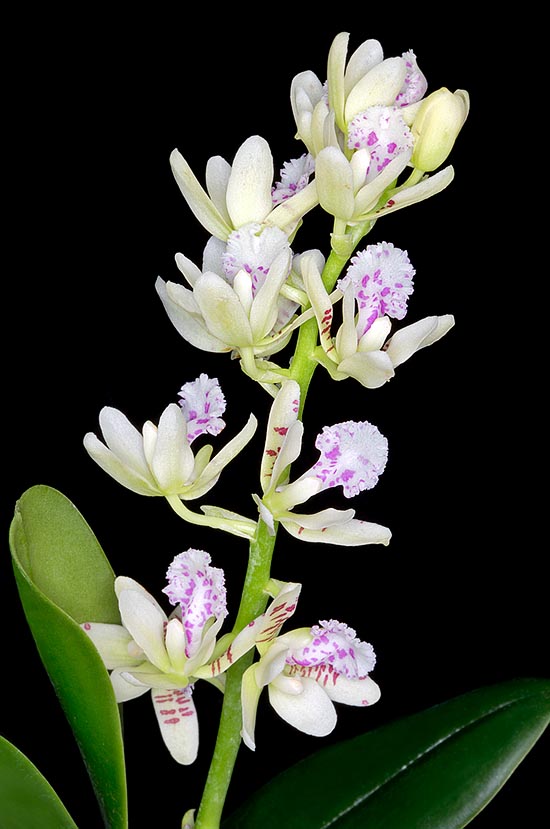Family : Orchidaceae

Text © Pietro Puccio

English translation by Mario Beltramini

Sedirea japonica is a miniature orchid, of fairly easy cultivation, native to China, Japan, Korea and Nansei-shoto Islands. The long-lasting flowers have the scent of lemon © Giuseppe Mazza
Sedirea is the name of the genus Aerides, where the species was previously inserted, spelled backwards; the specific name is the Latin adjective “japonicus, a, um” = of Japan, with reference to one of its origin places.
Common names: e ji lan (Chinese); nadopungnan (Korean); nago-ran (Japanese).
The Sedirea japonica (Rchb.f.) Garay & H.R.Sweet (1974) is a monopodial epiphytic species with short stem hidden by the foliar bases from which depart fleshy roots and alternate leaves, distichous oblong-elliptic with bilobed apex, 6-14 cm long and 2-3 cm broad, of dark green colour. Lateral racemose inflorescences, erect or arcuate, about 18 cm long, bearing up to 12 fleshy flowers of about 2,5 cm of diameter. Obovate dorsal, about 1,7 cm long and 0,7 cm broad, greenish white sepal, oblong lateral sepals almost of the same size, of greenish white colour with purple brown transversal bands in the lower half. Oblong-elliptic petals, about 1,5 cm long and 0,6 cm broad, greenish-white, trilobed labellum, 1,5-2 cm long and 1 cm broad, endowed at the base of a sort of a spur bent forward, about 1,3 cm long, with tiny lateral lobes and spatulate median lobe with wavy and corrugated margins, of whitish colour with pale purple spots; the column is about 1 cm long with curved apex. The long-lasting flowers, 3-4 weeks, emit an intense lemon fragrance.
It reproduces by seed, in vitro, by micropropagation and through the lateral ramifications that are possibly produced, to be detached when they have produced their own roots.
Miniature orchid, of relatively easy cultivation, requires a semi-shaded exposition in summer, much luminous, also filtered sunlight, in winter, medium temperatures, 18-28 °C in spring-summer, cooler in autumn-winter, with night temperatures of 8-12 °C, humidity, 50-70%, and a good and constant ventilation. During the growth the waterings must be regular, but without stagnations, easy cause to radical rottenness, letting to dry up slightly before giving water again, with fertilizations every two weeks using a balanced product, with microelements, specific for orchids, at half dosage. In winter to reduce the waterings, but without leaving to dry up completely, maintaining always a slight humidity, and to reduce the fertilizations to a monthly frequency with ¼ of dosage; for the waterings, to utilize rainwater, demineralized or by reverse osmosis. Cultivable in pots or baskets with much draining compost that may be formed by medium-large sized bark fragments and agri-perlite or other inert material, in way to allow the water to freely flow out and to avoid salts accumulation, to which the roots are very sensitive, or mounted on branches, bark, cork or arborescent ferns rafts, with eventualy some moss at the base of the plant. The repottings are to be done, when necessary, after the blooming.
The species is reported in the appendix II of the CITES (species whose trade is internationally ruled).
Synonyms : Aerides japonica Rchb.f. (1853).
→ For general notions about ORCHIDACEAE please click here.
